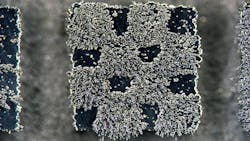Laser control in additive manufacturing leads to magnetic patterns in steel
A team of materials-science researchers at Empa, Swiss Federal Laboratories for Materials Science and Technology (Dübendorf, Switzerland) is turning a supposed disadvantage of laser-based additive manufacturing of certain metal alloys into a process that produces new alloys with novel properties embedded in 3D-printed metallic workpieces with micrometer precision.
Specifically, a metallic chessboard 4 mm on a side was produced in which the checkerboard squares alternate between magnetic and nonmagnetic regions (see figure). To achieve this, the researchers had only to vary the power and duration of the laser beam to alter the metal’s process microstructure, resulting in the ferromagnetic checkerboard.
The team, which led by Empa scientists Ariyan Arabi-Hashemi and Christian Leinenbach, used a type of stainless steel that was developed some 20 years ago by the company Hempel Special Metals in Dübendorf, among others. The so-called P2000 steel contains no nickel and around 1% of nitrogen; the material does not cause allergies and is well suited for medical applications. It is particularly hard, which makes conventional milling difficult. At first glance, it also seems unsuitable as a base material for 3D laser printing, as the temperature quickly peaks within the melting zone of the laser beam, causing a large part of the nitrogen within the metal to evaporate and changing the properties of the steel.
Varying melt-pool size
The researchers turned this drawback into an advantage by modifying the scanning speed of the laser and the intensity of the laser beam, which melts the particles in the metal powder bed, thus varying the size and lifetime of the liquid melt pool in a specified manner. The light source was a fiber laser emitting at a 1070 nm wavelength at a maximum power of 200 W in a spot size of 55 μm. The smallest melt pool created was 200 μm in diameter and 50 μm deep, while the largest melt pool was 350 μm wide and 200 μm deep.
The larger melt pool allowed much more nitrogen to evaporate from the alloy; the solidifying steel crystallized with a high proportion of magnetizable ferrite. In the case of the smallest melt pool, the melted steel solidified much faster; the nitrogen remained in the alloy and the steel crystallized mainly in the form of nonmagnetic austenite. During the experiment, the researchers had to precisely determine the nitrogen content in millimeter-sized metal samples and measure the local magnetization to within a few micrometers, as well as the volume ratio of austenitic and ferritic steel.
“In 3D laser printing, we can easily reach temperatures of more than 2500°C locally,” says Leinenbach. “This allows us to vaporize various components of an alloy in a targeted manner—for example, manganese, aluminum, zinc, carbon, and many more—and thus locally change the chemical composition of the alloy.” The method is not limited to stainless steels, but can also be useful for many other alloys, say the researchers.
In one example, for certain nickel-titanium alloys known as shape memory alloys, at what temperature the alloy “remembers” its programmed shape depends on just 0.1% more or less nickel in the mixture. Using a 3D laser printer, structural components could be manufactured that react locally and in a staggered manner to different temperatures.
The ability to produce different alloy compositions with micrometer precision in a single component could also be helpful in the design of more efficient electric motors, as it is now possible to build the stator and the rotor of the electric motor from magnetically finely structured materials, making better use of the geometry of the magnetic fields.
REFERENCE
1. A. Arabi-Hashemi et al., Appl. Mater. Today, 18, 100512 (2020).
About the Author
John Wallace
Senior Technical Editor (1998-2022)
John Wallace was with Laser Focus World for nearly 25 years, retiring in late June 2022. He obtained a bachelor's degree in mechanical engineering and physics at Rutgers University and a master's in optical engineering at the University of Rochester. Before becoming an editor, John worked as an engineer at RCA, Exxon, Eastman Kodak, and GCA Corporation.

